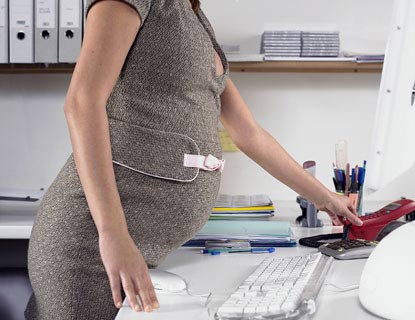|
 More than three decades after Congress passed a law trying to protect pregnant women in the workplace, discrimination is still widespread and needs to be combated with publicity and clearer guidelines, according to testimony Wednesday at a federal hearing. |
|
More than three decades after Congress passed a law trying to protect pregnant women in the workplace, discrimination is still widespread and needs to be combated with publicity and clearer guidelines, according to testimony Wednesday at a federal hearing. The Equal Employment Opportunity Commission's legal counsel, Peggy Mastroianni, said the agency had resolved 52,000 pregnancy cases since 2001, with $150.5 million paid out in damages. Discrimination against pregnant women includes firing, forced leave without pay, being denied a place to pump breast milk and being barred from some work, witnesses told the five-member EEOC panel at a hearing on the issue. Decades after the passage of the 1978 Pregnancy Discrimination Act, discrimination ranges from the shop floor to the executive suite, with sexual stereotyping a major factor. It is found in every state, but is more likely to hit women in low-income jobs, they said. "This many years after the Pregnancy Discrimination Act, we still have employers who still don't understand the basics. Are we getting the word out on fundamental issues?" said Commissioner Constance Barker. The issue of workplace discrimination was highlighted two weeks ago when a federal judge in Texas ruled against a Houston mother who said she was fired after asking for a place to pump breast milk. The EEOC helped litigate the case. General Counsel David Lopez said the agency was weighing whether to appeal the ruling. The Pregnancy Discrimination Act forbids discrimination by employers based on pregnancy, including hiring, firing, pay, job assignments and promotions. Under the law, pregnancy is considered a temporarily disabling condition. Witnesses said overlapping laws and rules, such as the Pregnancy Discrimination Act, the 1990 Americans With Disabilities Act and the Family and Medical Leave Act, had created gray areas that left employers uncertain about how to deal with pregnancy. One issue was how to compare treatment of a pregnant woman with that of other employees, they said. "In our view, the current laws are a little confusing and in some cases contradictory," said Deane Ilukowicz, a human relations executive with Hypertherm Inc, a Hanover, New Hampshire, maker of metal cutting gear. (Read by Nelly Min. Nelly Min is a journalist at the China Daily Website.) (Agencies) |
據周三美國聯邦法院聽證會的證詞顯示,在美國國會通過保護職場女性孕期權利的法律三十多年之后,職場女性懷孕依然廣泛遭受歧視,需要通過加大宣傳和制定更明確的指導方針來和歧視作斗爭。 平等就業機會委員會的法律顧問佩奇?馬斯楚安尼說,自2001年以來,委員會已經處理了5.2萬起懷孕案件,涉及的傷害賠償金達1.505億美元。 在聽證會上,證人告訴平等就業機會委員會的五人評判小組說,對懷孕女性的歧視包括解雇、強迫停薪留職、拒絕提供哺乳場所和禁止從事部分工作。 在通過1978年《懷孕歧視法案》幾十年之后,不管是普通員工,還是管理層,很大程度上依然存在性別成見。他們說,對懷孕女性的歧視在美國各州都廣泛存在,而低收入職業女性更容易遭受歧視。 委員會委員康斯坦斯?巴克說:“通過《懷孕歧視法案》后這么多年來,還是有雇主不理解該法案的基本要義。我們是否有效傳播了有關基本問題的法規?” 職場女性歧視問題在兩周前成為了眾人關注的焦點。一位來自休斯敦的母親稱自己要求單位提供哺乳場所,結果被解雇,得克薩斯州的一名聯邦法官判決這位母親敗訴。 平等就業機會委員會幫助就這一案件進行爭訟。總法律顧問戴維?洛佩茨說,委員會在考慮是否要對該判決提出上訴。 《懷孕歧視法案》禁止雇主的懷孕歧視行為,包括雇傭、解雇、發薪、工作分配和提升等各個方面。依據該法律,懷孕被視為暫時喪失勞動能力的狀態。 證人說,法律法規的重疊,例如《懷孕歧視法案》、1990年《美國殘疾人法案》和《家庭與醫療休假法案》,制造了灰色地帶,讓雇主不確定如何處理懷孕問題。 他們說,其中一個問題是如何比較懷孕女性的待遇和其他員工的待遇。 美國海寶公司的人力總監迪恩?伊路科維奇說:“在我們看來,現行的法律有點混亂,某些情況下甚至自相矛盾。”海寶公司是新罕布什爾州漢諾威一家生產金屬切割儀器的企業。 相關閱讀 (中國日報網英語點津 陳丹妮 編輯:Julie) |
|
Vocabulary: shop floor: (工廠工人的)工作場所 get the word out: 散播、傳播消息,把消息傳開去 litigate: 就……爭訟 appeal: 對……上訴 |
